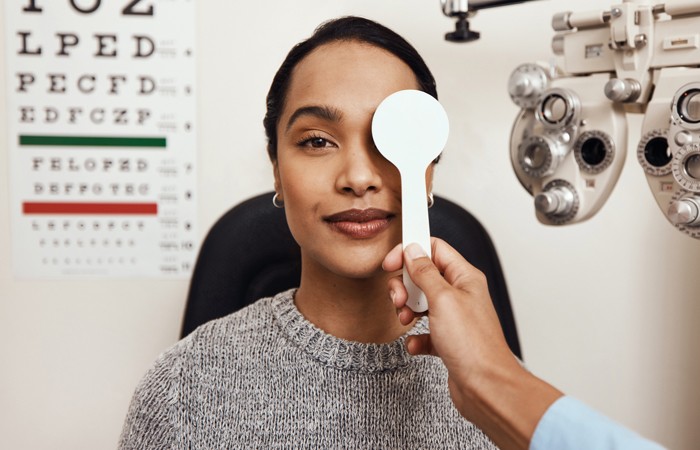In OTC Category Reviews
Follow month by month updates on topics including asthma, mental health and skin conditions and be able to provide informed advice to customers at the counter.Bookmark
It seems that the eyes are unfortunately frequently overlooked with just one in four UK adults rating routine eye tests as important for maintaining good eye health, according to the Eye Q report, commissioned by organisation Eye Health UK and charity Thomas Pocklington Trust in September 2022 to mark the annual National Eye Health Week.
Worryingly, the report found that more than 17.5 million people haven’t had an eye test in the last two years, as recommended by opticians, with men and minority ethnic groups most likely to skip this essential health check.
It’s probably no surprise that the report also found that 77 per cent of adults suffered poor eye health in the last 12 months, while more than half said their daily lives have been disrupted by the quality of their vision – affecting their ability to do daily activities such as household chores or driving.
“With 60 per cent of us worrying about our long-term vision, it’s time for us to wise up and learn how to look after our eyes,” says David Cartwright, optometrist and chair of Eye Health UK. “Making some simple changes to our lifestyle and having regular eye tests could give our eye health a boost and prevent future sight loss.”
Pharmacy teams are well-placed to support their customers’ eye health, from spotting common conditions to making vital referrals when something could be serious. “Pharmacies are often one of the first ports of call for patients with a range of minor eye conditions,” says Max Halford, clinical lead for the Association of British Dispensing Opticians. “Although they may not have access to the specialist clinical skills and diagnostic equipment available within an optician’s practice, they still have an important role to play in offering advice, guidance and management options.”
Common types of eye conditions
Pink or red eyes are usually nothing to worry about, especially if they don’t hurt and sight isn’t affected, but it’s important to establish a cause. A ‘bloodshot eye’ – a bright red area in the white of the eye – is probably due to a burst blood vessel. If the eye feels gritty or burning, it’s most likely to be conjunctivitis, especially if the eye is sticky too. Sore, blurring or watery eyes are likely to be dry eyes, while itchy, sore or red eyelids are usually caused by blepharitis.
If the eye isn’t any better after a few days, it’s important that the customer sees an optometrist or their GP. In the meantime, they shouldn’t touch or rub their eye or wear contact lenses. They may be able to try over-the-counter (OTC) treatments for common eye problems, such as irritated eyes, conjunctivitis or blepharitis, depending on the symptoms. But they should seek medical help straightaway if they have red eyes and any changes to their vision, it hurts to look at light, they have a severe headache and feel sick, one pupil is larger than the other, their eyes are very dark red, or they’ve experienced an injury to their eye.
Conjunctivitis is due to inflammation of the thin transparent film that covers the white part of the eye and under the upper eyelid. It’s usually caused by an infection or allergy. Viral or bacterial conjunctivitis should get better in a couple of weeks without any treatment. However, some sexually transmitted infections, such as gonorrhoea and chlamydia, can cause conjunctivitis symptoms for longer than this. Allergic conjunctivitis usually lasts for a few months or may even be present all year round.
“Bacterial conjunctivitis is typically accompanied by a yellow/green discharge,” explains Max. “This helps differentiate it from allergic conjunctivitis with a clearer discharge. Treatment should be appropriate for the condition, although bacterial conjunctivitis is usually a self-limiting condition.”
Viral or bacterial conjunctivitis is highly contagious so it’s important to follow good hygiene while the symptoms last – taking care not to pass it onto someone else. To ease the symptoms, customers should be advised to boil some water and leave it to cool down. Then soak some cotton balls in the water and gently wipe any crusts from the eyes. They can do this in the morning and up to two more times during the day. Holding a cold flannel to their eyes will cool down any burning or itching.
Pharmacy customers can also buy eye drops, sprays and pads to soothe allergy symptoms, OTC eye drops for minor eye infections and chloramphenicol-containing eye ointments for bacterial conjunctivitis.
Eye floaters are little flecks in the vision that become more noticeable when looking at a bright and plain background such as a white wall. When moving the eyes, the floaters quickly shift to the side and can’t be seen anymore. Eye floaters never completely go away, but they often get less visible over time as the brain gets used to them.
“Floaters can be the early sign of a more serious eye condition such as retinal detachment or a less-worrying part of the eyes’ ageing process, such as a posterior vitreous detachment,” says Max. “Without specialist equipment to examine the posterior eye, pharmacists should refer patients to their optician’s practice or if associated with vision loss to seek urgent or emergency eyecare within the hospital eye service or A&E.”
Alastair Lockwood, ophthalmologist and eye health advisor for Feel Good Contacts, says that eye floaters are usually nothing to worry about, but a sudden increase needs to be checked out, as well as a dark shadow or curtain in one side of peripheral vision. “Age-related eye floaters can’t be prevented,” he says. “However, you can avoid eye floaters caused by injury by wearing eyewear to protect your eyes when carrying out tasks that require the use of dangerous tools or when playing certain sports. You can reduce the likelihood of getting floaters as a result of a vitreous haemorrhage caused by diabetic retinopathy, by improving your blood sugar levels.”
Most people get one or two styes in their lifetime. A stye is a small pus-containing abscess on the outside of the eyelid, usually caused by a bacterial infection. It looks like a small red lump with a yellow spot in the middle and may cause a red and watery eye or eyelid.
“Styes can be quite painful,” says Max. “They appear often overnight, and it is the discomfort that distinguishes them from a chalazion (a minor infection of the Meibomian glands). Management is to try and remove the eyelash if that’s still in place and hot compresses.”
The customer should apply consistent heat to the stye for a minimum of seven to 10 minutes at a time. “This is often difficult to achieve with a face cloth and wash basin of water, so a microwavable eye bag is often recommended,” adds Max. “If home treatment is ineffective, then routine referral to GP is recommended for antibiotic treatment or onward referral.”
Blepharitis is caused by inflammation of the rims of the eyelids. It’s often a reaction to bacteria that live naturally on the eyelid skin, which then affects oil production. Symptoms include burning, soreness or stinging in the eyes, crusty eyelashes and itchy eyelids. The condition is more common in people with seborrheic dermatitis, rosacea or acne, or may be caused by preservatives in glaucoma eye drops.
Blepharitis can often be treated with warm compresses to improve the flow of oil in the eyelids. Using an eyelid cleansing product (e.g., gel, foam, wipes) may help with lid hygiene to remove debris, dirt, oil and pollen. There are also eyelid products to improve oil production and/or kill a broad spectrum of bacteria, viruses and fungi.
“Blepharitis is one of the most common underlying reasons that cause patients to seek dry eye advice,” says Max. “Therefore, patients presenting with sore red lid margins should be offered appropriate over-the-counter blepharitis treatment along with suitable evaporative dry eye products.”

Time to be screen smart
More and more people are suffering from screen fatigue – headaches, sore or tired eyes and temporary blurring of vision – because they don’t know how to be screen smart, according to the Eye Q report. Just one in seven people follow the 20-20-20 rule (look away from the screen every 20 minutes and focus on something 20 feet away for 20 seconds), only 28 per cent adjust room lighting, and four in five don’t consciously blink.
Sitting in front of a screen regularly for long periods means people blink less often. This can mean that tears don’t spread over the surface of their eyes and may evaporate more quickly, leaving their eyes dry and uncomfortable. A recent YouGov survey of 2,000 people by Théa Pharmaceuticals found that in the UK, diagnoses of dry eye have doubled in the last year with over a third of British people now being diagnosed.
Dry eyes can usually be eased with lid hygiene or massage, heated eye masks or flannels, and artificial tears or lubricating eye drops, but it’s important that customers speak to their optometrist about the best dry eye products to use before they buy them. “There are different types of dry eye: aqueous deficient or evaporative dry eye or mixed dry eye disease,” says Max. “Most dry eye products are specifically designed to treat a certain type of dry eye symptoms. Often a good approach is carefully questioning about the symptoms and consideration of the cause before recommending any specific product.”
Aqueous deficiency is when there isn’t enough tear production, and evaporative dry eye, caused by a deficient tear film oil layer, increases tear evaporation.
“For evaporative dry eye, lipid-based supplements and lubricants can be purchased as liposomal sprays,” adds Max. “These contain mineral oils and/or phospholipids, fatty acids or triglycerides and are made as emulsions, allowing the oil and water to mix. For aqueous-deficient dry eye, osmolarity-balanced artificial tears are recommended.”
Colour blindness
Colour blindness in children is rarely a sign of anything serious. It’s usually inherited from their parents and is present from birth. Around one in 12 men and one in 200 women have problems with distinguishing between red, yellow and green shades, which can affect how they distinguish red from black and shades of purples, browns and oranges too. In rare cases, people have trouble with blues, greens and yellows instead.
Most children learn to adapt to colour vision deficiency, but it can sometimes affect learning at school (if colours are being used in class, for example) or knowing what’s safe to eat (such as unripe bananas or undercooked meat).
If parents are worried that their child is having trouble distinguishing colours, they should speak to their optometrist, as several colour vision tests are available. For more information, they can visit the Colour Blind Awareness charity.
Sponsored
 Sponsored education
Sponsored education
Managing fever in children
Get to grips with the current guidance on managing fever in children and how antipyretics can help, and discover products you can recommend.
 Sponsored education
Sponsored education
The role of nasal cleansing in protecting against colds and flu
Learning for the pharmacy team


Record my learning outcomes